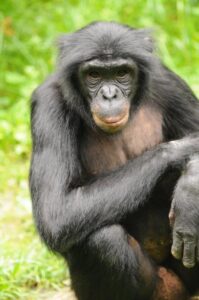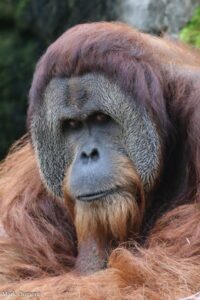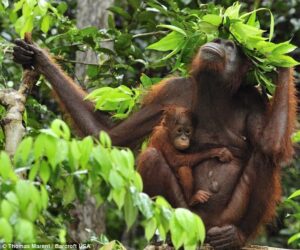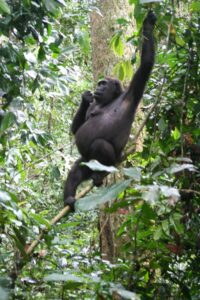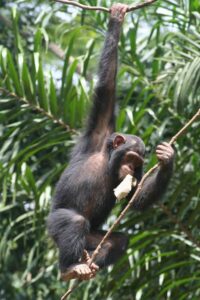World Great Ape Day and the Cincinnati Zoo
On Sept 9, 2017 the Association of Zoos and Aquariums (AZA), the Cincinnati Zoo & Botanical Garden (CZBG) and conservation organizations across the planet recognize World Great Ape Day. This charismatic group of primates has been part of our community throughout most of the Cincinnati Zoo’s long, rich history. CZBG has had the honor to share chimpanzees, western lowland gorillas, Bornean orangutans, Sumatran orangutans and bonobos with millions of guests, friends and followers over those many years. Although the focus, goals and how we care for great apes has evolved greatly since the early days, one constant has held firm throughout; their compelling ability to engage and inspire all of us to care. One look into the deep, contemplative eyes of a chimp, bonobo, gorilla or orangutan and you realize the undeniable kindred connection to ourselves. When digging a bit further, we discover this connection goes far beyond just our physical similarities.
The great apes are man’s closest living relatives, sharing over 98% of the same DNA. Although certainly not an ancestor of humans, they have followed along on a common path throughout the centuries. Using special adaptations like stereoscopic vision, dexterous hands, opposable thumbs and the largest brains per body mass, apes like humans have developed dynamic social structures and can effectively manipulate their environments to suit their needs, key to their success.
Here at the zoo, bonobos have been part of our family for over 30 years. These highly intelligent, clever apes connect with guest at the zoo’s rainforest emersion habitat, “Jungle Trails”. CZBG has been one of the primary supporters of bonobos conservation in North America and has produced 10 births! We work closely with other zoos and the AZA’s Species Survival Plan to cooperatively manage this endangered species while learning all we can about them through collaborative health and behavioral research. Apes are never removed from the wild for North American accredited zoos so genetics and welfare are meticulously managed.
Closely related to chimpanzees, bonobos diverged from their more physically robust and behaviorally aggressive counterparts as they developed their “make love, not war” communities. Found only in the Democratic Republic of Congo (DRC) and isolated from other ape species bonobos have been dubbed the “hippie apes”. Unlike the other ape species, female bonobos are receptive for breeding anytime. Competition from males for female attention diminished, allowing a matriarchal order led by strong female coalitions. Bonobos diffuse tensions and bond through frequent breeding behaviors, embracing and long grooming sessions. Unfortunately, this Shangri-La society is threatened by continued deforestation and expansive mineral mining. Columbite-tantalite or coltan is mined extensively for use in our cell phones. The mining practices there create many human welfare issues and contribute to the decline of bonobos populations as they are being consumed as bushmeat or food by the workers. It’s a complex and challenging problem. To help, CZBG has partnered with Eco -Cell to collect and recycle old cell phones and cell phone products. By reusing coltan, we reduce the need for as much of it to be taken from bonobo and gorilla habitats and the profits made are then reinvested back into to our wild ape conservation efforts in Central Africa. You can learn more at www.cincinnatizoo.org.
Also, hanging out at Jungle Trails are Sumatran orangutans. The word orangutan means “people of the forest”. Orangs have adapted to the swampy nature of their Indonesian rainforest habitats by becoming the largest arboreal or tree dwelling species on the planet. Because they are so large, a life in trees doesn’t support multi-member family groups as happens with the more terrestrial chimps, gorillas, bonobos and humans. So, orangs will live solitary much of the time. As a result, they have become excellent problem solvers since they cannot depend on someone else to show them how to do something once they leave the instruction of their mothers at around 8 years old. Like the other apes, orangs are excellent tool users and manipulate items to create things like umbrella hats to cover their heads when it rains. Although they thrive in zoos living sometimes into their 50s, wild Sumatran orangs are a critically endangered species. The number one threat being deforestation for oil palm plantations. Palm oil is used in thousands of products we commonly consume and use like, cookies, candy, cosmetics and soaps. If left unchecked orangs could disappear from the wild in many of our lifetimes. To help CZBG has created an orangutan-safe, sustainably-produced palm oil shopping guide app for your phone. It helps guide you to safe options as shop for these items. You can learn more and download the app at www.cincinnatizoo.org .
Another critical commonality between humans and apes is the life sustaining need for healthy rainforests across the planet. Although they only cover about 2% of Earth’s surface they are home to over half of all plant and animal species. Referred to as the “Lungs of the Planet”, they produce a disproportionate percentage of our oxygen and serve as great water reservoirs, distributing rainfall for us all. They diffuse light reflection from the sun important to maintaining climate balance. Many of the common medications and drugs we depend on were derived from rainforest plant species with other uses waiting to be discovered. Unfortunately, rainforests are being cut down at an unsustainable rate across the globe. Of course, apes have a more direct need for rainforests, depending on them for their very lives. Apes are “gardeners of the rainforest” and critical to their vitality. Through continuous foraging they stimulate fresh new growth while spreading seeds in their dung as they travel great distances across the forest. Rainforests can’t thrive without apes, humans cannot thrive without rainforests.
The Cincinnati Zoo is dedicated to the mission of inspiring guests with apes while providing the highest quality care, state of the art facilities, participating in research and supporting in situ conservation. We are dedicated to channeling that inspiration to learn more and take action. Recycle, reuse, repurpose, reduce everything possible in our everyday lives! Recycle cell phones with us to make a direct impact on ape conservation and support eco-tourism by visiting apes in the wild if you can. Together we are and can continue to make a difference. Visit the zoo’s website for more information about our environmental suitability efforts.
After recognizing World Great Ape Day, CZBG will be gearing up for the first World Gorilla Day on Sept 24! From “Susie” the zoo’s first gorilla in the 1930’s through little ‘Elle”, the 50th gorilla born here, gorillas have been a cornerstone at the Cincinnati Zoo for over 80 years! Please look for an additional blog coming soon covering CZBG’s rich history and bright future with this conservation flagship species. In addition to the blog and social media posts, we will be celebrating World Gorilla Day at the zoo with some interactive activities, gorilla enrichment demonstrations, extra keeper talks, giveaways and more. Helping us celebrate will be our gorilla conservation partners from Gorilla Glue and Eco-Cell.








